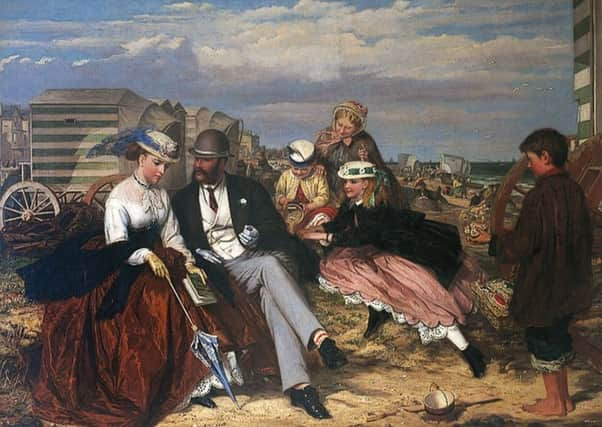Exhibit of the Week: Courtship on the Beach by Charles Wynne Nicholls, Scarborough Collections


Courtship on the Beach is one of his best known paintings and is held in the Scarborough Collections. The young lady is receiving the undivided attention of a fashionable gentleman on the beach at Margate. She has a shy look on her face but is in fact reading a rather scandalous book of the time called Lady Audley’s Secret (1862). The older woman pictured is possibly a nanny to the children or chaperone to the young lady. She is telling the children off for pouring sand into the gentleman’s pocket while he is distracted. Their rich clothing is in contrast to the poor boy on the right selling seashell trinkets; the types of souvenirs still found at many coastal destinations today and a rare survival from the Victorian heyday of the seaside resort.
Is the young lady shy or is she perhaps bored? Could she possibly be wishing the young man would leave her alone so she can return to the thrilling plot of her book? Lady Audley’s Secret is still a well-known and sought-after novel today. It was written by Mary Elizabeth Braddon and was followed by a sequel, Aurora Floyd, in 1863. Braddon based the novel, in part, on the real-life case of Constance Kent. In June 1860, the 16 year old Constance killed her three year old half-brother, Francis. She was prosecuted for the murder in 1865 and confessed her guilt to an Anglo-Catholic priest. She was imprisoned for 20 years and released in 1885. Constance later emigrated to Australia where she died aged 100 in 1944. This crime was featured in the popular 2011 ITV drama The Suspicions of Mr Whicher.
Advertisement
Hide AdAdvertisement
Hide AdPerhaps a brief look at the plot of Lady Audley’s Secret will reveal why the young lady in our painting might have rather read her novel than entertain the advances of the fashionable young man. The pivotal theme of the book is accidental bigamy, which was a fashionable topic during the 1860s. In short, the heroine of the novel is Lucy Graham who married a middle-aged wealthy widower, Sir Michael Audley in 1857. She is said to be blonde, beautiful and rather childlike. She met Sir Michael while she was employed as a governess for the local doctor and before that she was in service. However, little is known of her past before she moved to the area. Sir Michael’s nephew is a barrister called Robert Audley. He is friends with a man called George Talboys, who has been away in Australia for three years prospecting for gold. On his return, Robert welcomes him home and George is keen to be re-united with his wife Helen who he left in financial difficulty. He soon learns from a newspaper that she is dead. In an effort to occupy his friend’s mind with something more pleasant, Robert offers to take George to visit his uncle, Sir Michael at Audley Court. While there, Lady Audley does everything possible to avoid their company. Nevertheless, George is shown a portrait of the lady of the house by Alicia Audley, Robert’s cousin, and is badly affected by what he sees. Not long after, George disappears. It later transpires that Lady Audley is in fact Helen Talboys, George’s ‘dead’ wife. After her first husband left for Australia, she abandoned her old life and their child Georgey in search of a rich husband and a better life. Towards the end of the book, Robert discovers that George was pushed down an old well by Lady Audley in an attempt to kill him but that he had managed to escape and flee the country. When Robert confronts Lady Audley she sets fire to Castle Inn, where he is staying, in the hopes of killing him but does not succeed. He confronts her again and she is forced to reveal her secret. Her current husband, Sir Michael, leaves for Europe with Alicia, and Lucy is sent to a mental asylum in Belgium where she later dies. Robert still believes his friend George is dead but the landlord of the Castle Inn, Luke Marks, who was injured during the fire set by Lucy, reveals on his deathbed that George survived and he helped him to flee the country. George then returns from New York and the book ends with the two friends living in a country cottage together, along with young Georgey and Robert’s new wife, George’s sister Clara. This is a very brief and simple overview of the novel with only the main points summarised; it gives the reader a sense of how complicated and involved the plot really is.
Courtship on the Beach is currently on display in Scarborough Art Gallery as part of a major rehang of the collection. Several favourite pieces, such as this one, are still on display alongside a range of works that have been brought out of storage, many of which have never been on show before.
Courtship on the Beach is part of the Scarborough Collections, the name given to all the museum objects and artwork acquired by the borough over the years, and now in the care of Scarborough Museums Trust. For further information, [email protected] or 01723 384510.